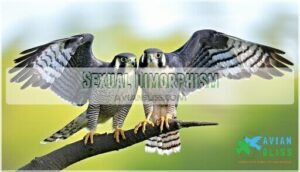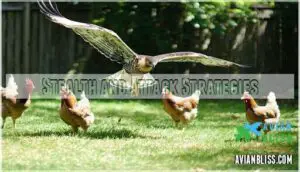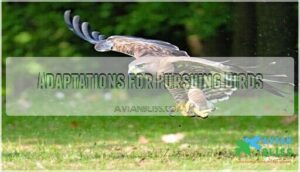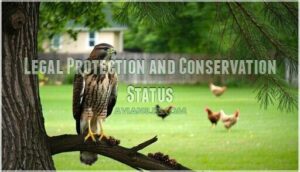This site is supported by our readers. We may earn a commission, at no cost to you, if you purchase through links.

Females outweigh males by 30-35%, making them particularly formidable hunters. Cooper’s hawks thrive everywhere from woodlands to suburban neighborhoods, adapting brilliantly to urban life by targeting bird feeders and backyard flocks. Their short, rounded wings and long tails make them aerial acrobats capable of threading through tight spaces at breakneck speed.
These federally protected raptors have rebounded strongly since DDT bans, but their success creates real challenges for poultry keepers who need smart strategies to protect their birds.
Table Of Contents
- Key Takeaways
- Cooper’s Hawk Identification and Physical Traits
- Habitat, Range, and Adaptability
- Hunting Techniques and Diet
- Protecting Chickens From Cooper’s Hawks
- Legal Protection and Conservation Status
- Frequently Asked Questions (FAQs)
- What do Coopers hawks eat?
- Where do Coopers hawks nest?
- Whats their conservation status?
- How do they adapt to cities?
- Where do they migrate?
- How long do Coopers hawks live?
- When do Coopers hawks breed and nest?
- What sounds do Coopers hawks make?
- Do Coopers hawks migrate in winter?
- How many eggs do Coopers hawks lay?
- Conclusion
Key Takeaways
- You’ll recognize Cooper’s hawks by their orange-red eyes, gray-blue backs with rufous-barred chests, and medium size (14-20 inches) – they’re larger than sharp-shinned hawks with rounded tails and excel at threading through dense cover at high speed.
- These federally protected raptors use stealth and surprise attacks to hunt birds, making your backyard chickens prime targets – they’ll strike during daylight hours and can take down full-grown chickens despite weighing only 10-24 ounces.
- You can protect your flock with covered runs, reflective deterrents, and supervised free-ranging – hardware cloth beats chicken wire, while shiny objects like CDs and reflective tape create visual chaos that confuses hunting hawks.
- Cooper’s hawks have made a remarkable comeback since DDT bans, now thriving in both woodlands and suburban areas – their adaptability to urban environments means they’re increasingly common around bird feeders and backyard coops.
Cooper’s Hawk Identification and Physical Traits
You’ll recognize a Cooper’s hawk by its distinctive medium size, measuring 14–20 inches long with a 27–34 inch wingspan.
The adults sport gray-blue backs, white undersides with rufous bars, and striking orange-red eyes, while younger birds show brown plumage with yellow eyes.
Size, Wingspan, and Weight
You’ll notice Cooper’s hawks are medium-sized raptors with impressive Wing Measurement spanning 27-34 inches. These Coopers Hawk predators pack surprising Physical Attributes – Body Mass ranges from 10-24 ounces, making them lighter than they appear.
For Size Comparison, they’re crow-sized but built for agility. Weight Factors vary substantially between males (around 10 oz) and females (up to 24 oz), unlike the smaller SharpShinned Hawk.
Plumage and Eye Color
You’ll easily distinguish Cooper’s hawks by their striking adult plumage featuring gray-blue backs contrasting with white undersides streaked with rufous bars. Their eye coloration transforms dramatically from yellow in juveniles to brilliant orange-red in adults.
Young Coopers hawk display brown feather patterns with heavy streaking, providing visual camouflage unlike the sharpshinned hawk’s finer streaks or red shouldered hawk’s distinct shoulder patches.
Sexual Dimorphism
Cooper’s hawks showcase dramatic size differences between sexes, with females outweighing males by 30-35%. This dimorphic trait influences their mating habits and hunting strategies. You’ll spot these differences when observing Cooper’s hawk behavior during breeding season, as larger females often dominate territory selection while males handle courtship displays.
- Female Weight Advantage – Females weigh up to 24 ounces compared to males at 10 ounces
- Hunting Role Division – Larger females target bigger prey while males focus on smaller birds
- Nesting Dynamics – Size differences affect gender roles during egg incubation and chick feeding
- Territory Defense – Dimorphic traits help establish dominance hierarchies within breeding pairs
- Survival Strategy – Sex ratio benefits from varied hunting capabilities reducing competition pressure
Understanding the hawk size comparison is essential for identifying these birds in the wild.
Differences From Similar Raptors
How do you tell Cooper’s Hawks apart from other raptors? Sharp-shinned Hawks are smaller with squared tails, while Cooper’s Hawks have rounded tails. Peregrine Falcons boast pointed wings and incredible speed during bird attacks.
Red Shouldered Hawks prefer woodland perches and have broader wings. Cooper’s Hawk behavior includes aggressive hunting through dense cover, unlike the open-sky flight patterns of other hawk species. Cooper’s Hawks have distinctive characteristics that set them apart from other raptors.
Habitat, Range, and Adaptability
Cooper’s hawks thrive in both wild forests and your neighborhood, making them one of North America’s most adaptable raptors.
You’ll find these skilled hunters from southern Canada down to Mexico, seamlessly switching between dense woodlands and suburban backyards where bird feeders create easy hunting opportunities.
Preferred Natural Habitats
Woodland ecosystems provide Cooper’s Hawks with their ideal hunting grounds, where dense canopy meets opportunity. These skilled predators thrive in diverse forest environments that offer both cover and abundant prey.
Their preferred habitats include:
- Forest Edges – where woods meet open spaces, creating prime hunting zones
- Riparian Zones – wooded areas along streams with increased prey density
- Mature Pine Stands – offering 55-70% canopy coverage for nesting security
Oregon studies reveal these hawks select forests with ideal tree density, while habitat fragmentation actually benefits some populations by creating more edge effects that enhance hunting success in backyard settings. The hawks’ hunting techniques are highly adapted to these environments, allowing them to thrive in various conditions.
Urban and Suburban Adaptations
Unlike their forest-dwelling cousins, these hawks have mastered Urban Habitats with remarkable success. You’ll spot them nesting in suburban backyards, hunting City Prey like pigeons and songbirds with Adaptive Hunting techniques.
Their Coopers Hawk Behavior shows incredible Human Coexistence skills, thriving near homes where Suburban Nesting sites and abundant bird feeders create perfect hunting grounds for suburban backyard farming areas.
Geographic Distribution and Migration
Throughout North America, Cooper’s Hawks demonstrate remarkable flexibility in their geographic reach. These adaptable raptors breed across territories spanning from southern Canada down to northern Mexico, with particularly strong populations in Oregon’s diverse landscapes.
Migration patterns reveal their survival instincts:
- Northern populations escape harsh winters by flying south
- Southern birds often stay put year-round like permanent residents
- Wintering areas extend through Central America to Honduras
- Range expansion continues as habitat fragmentation creates new opportunities
- Breeding grounds now include urban parks where Hawk Attacks on backyard chickens increase
Their distribution shifts seasonally, and effective Coopers Hawk deterrents become essential as these skilled predators follow prey movements and adapt to changing environments across their expanding range.
Hunting Techniques and Diet
You’ll quickly discover that Cooper’s hawks are incredibly effective hunters, using stealth and surprise to catch their prey off guard.
These skilled raptors employ a variety of attack strategies, from low-flying swoops to high-velocity dives, making them particularly dangerous to backyard chickens and smaller birds, as they utilize high-velocity dives.
Stealth and Attack Strategies
In a split second, Cooper’s hawks transform from motionless statues into lightning-fast predators. These aerial assassins use swoop attacks and silent strikes to catch prey off-guard, diving from tree perches at incredible hunting speed for their deadly aerial ambush.
From perch to prey in a heartbeat – Cooper’s hawks strike with deadly precision
| Attack Phase | Hawk Behavior | Victim Response | Outcome |
|---|---|---|---|
| Approach | Silent glide from cover | Unaware grazing | Element of surprise secured |
| Strike | Dive bomb with extended talons | Panic scatter attempt | Talon tactics deployed |
| Capture | Pin prey to ground | Struggle for escape | Hawk attack techniques successful |
| Feeding | Strip feathers methodically | — | Silent strikes complete |
These Coopers use stealth over brute force, making Coopers hawk deterrents essential for protecting backyard flocks from their devastating hawk attacks.
Common Prey and Feeding Habits
Cooper’s hawks are opportunistic predators with diverse Prey Selection and Feeding Behavior. Birds make up 71% of their diet, while mammals contribute 18%. Their Foraging Strategies adapt to local availability, making them effective Chicken Predators. These birds often engage in hunting behavior techniques to catch their prey.
Daily requirements include:
- Two birds killed per day (roughly 700 annually)
- 12% of body weight in food needed daily
- 15-166 gram prey range with 113-136 gram average
These Predator Prey dynamics showcase remarkable hunting efficiency.
Adaptations for Pursuing Birds
Everything about these raptors screams "bird-hunting machine." Their short, rounded wings and long tails let them pull off incredible Flight Maneuvers through dense trees. When Coopers dive bomb from above, their razor-sharp talons lock onto prey with deadly precision. You’ll notice their Hunting Strategies rely on speed and surprise.
| Physical Adaptation | Hunting Advantage |
|---|---|
| Short, rounded wings | Quick turns through vegetation |
| Long tail | Steering control during Aerial Pursuit |
| Curved talons | Secure grip on struggling prey |
Their Talon Structure delivers crushing force while their keen eyes track every movement below.
Impact on Backyard Chickens
Beyond the backyard fence, your chickens face a formidable aerial threat. Cooper’s Hawks successfully hunt standard and bantam breeds, consuming up to half their body weight in chicken meat. Free range risks increase during daylight hours when these skilled predators strike.
Chicken predation events leave lasting impacts on flock safety, making backyard chicken protection essential through proven hawk deterrents and predator control methods.
Protecting Chickens From Cooper’s Hawks
You can’t stop Cooper’s hawks from hunting, but you can make your chickens less appealing targets with smart prevention strategies.
From covered runs to reflective deterrents, protecting your flock requires understanding how these skilled predators operate and when they’re most likely to strike.
Risks to Backyard Poultry
Your backyard flock faces real danger from Cooper’s hawks, which successfully attack full-grown chickens despite their size. These skilled predators use lightning-fast swooping attacks, pinning birds with razor-sharp talons. Even survivors often suffer fatal injuries or flock rejection.
Free ranging risks increase dramatically during daylight hours when these relentless hunters patrol neighborhoods, making backyard chicken protection and thorough bird loss prevention strategies absolutely essential. To mitigate these risks, investing in proper chicken coop covers can be a vital step in safeguarding your flock, particularly through the use of chicken coop covers and ensuring proper backyard chicken protection.
Effective Deterrents and Barriers
Protecting your flock doesn’t have to feel like an uphill battle. Effective hawk control methods combine multiple strategies to create an impenetrable fortress around your birds.
Three proven deterrent approaches:
- Reflective deterrents – Old CDs, reflective tape, and shiny pinwheels create visual chaos that confuses Coopers during hunting approaches
- Secure coops – Hardware cloth beats chickenwire every time, while hawk netting overhead blocks aerial attacks completely
- Visual barriers – Dense shrubs, low shelters, and natural cover give chickens quick escape routes when hawks appear
Bird netting stretched tight across runs offers near-total protection. Noise devices add another layer of confusion for hunting hawks. For maximum protection, consider using hawk netting systems to cover outdoor areas.
Supervision and Flock Management
Your presence acts as the best predator deterrent when chickens roam freely. Stay within sight during free range safety periods, especially mornings when Coopers hunt most actively. Watch treetops for perched hawks and listen for alarm calls from your flock.
Chicken guarding means being ready to intervene with noise or water spray during hawk attacks. Effective flock monitoring prevents most chicken predator management issues before they escalate. Implementing automatic Chicken Guard Systems can enhance the security of your coop. Your presence and interventions are key to free range safety.
Personal Experiences and Prevention Tips
When you witness a hawk attack, your heart pounds as talons dig into feathers. Chicken Guarding becomes personal after losing hens to Coopers. Backyard Security means immediate action—reflective tape, covered runs, and supervised free-ranging work.
Predator Deterrents like noisemakers save lives. Flock Safety Tips include watching treetops and confining birds after sightings. These Chicken Protection Methods turn hawk attack stories into prevention victories.
Attracting crows can be beneficial as they participate in crow protection services to help safeguard the flock.
Legal Protection and Conservation Status
You might be surprised to learn that Cooper’s hawks are federally protected under the Migratory Bird Treaty Act, making it illegal to harm or kill them without special permits.
Despite their reputation as chicken thieves, these raptors have made a remarkable comeback from near-extinction in the 1970s, when DDT poisoning and hunting reduced their numbers by up to 40% annually.
Wildlife Conservation Laws
Under federal Wildlife Conservation Laws, Cooper’s hawks enjoy ironclad protection through the Migratory Bird Act, making unauthorized hawk control illegal. These Environmental Regulations safeguard Coopers and Peregrine Falcons alike, though you can pursue legal solutions for persistent problems.
Here’s what you need to know:
- Hawk Permits – Government agencies may grant special permits if hawks continuously harass your flock
- Heavy Penalties – Unauthorized killing carries fines up to $15,000 plus potential jail time
- Legal Alternatives – Focus on deterrents and Backyard Chicken Safety measures instead
Historical and Current Population Trends
Cooper’s Hawks hit rock bottom during the mid-20th century when Population Decline reached crisis levels—shooters killed nearly half of first-year birds annually. DDT made things worse, thinning eggshells and crushing Recovery Trends.
But here’s the comeback story: after DDT’s ban in 1972, these adaptable Coopers bounced back dramatically. Conservation Efforts and Wildlife Conservation Laws sparked a population explosion through the 1980s and 1990s.
Today’s estimated 100,000 to 1,000,000 individuals prove Species Adaptation works wonders when we give wildlife a fighting chance.
Human-Wildlife Conflict Solutions
When hawks threaten your flock, you’ve got options beyond throwing in the towel. Wildlife Management experts recommend Hawk Deterrents like reflective tape and hunter’s orange tape for effective Chicken Safety.
These Conservation Strategies reduce conflict while protecting your birds. Supervised free-ranging and covered runs offer backyard chicken protection. Smart Urban Planning creates win-win scenarios where Hawk Control Methods keep everyone happy.
Ongoing Conservation Efforts
Today’s wildlife management strategies focus on creating win-win scenarios for both raptors and backyard chicken keepers. Game wardens work closely with local communities to implement effective solutions.
Conservation efforts now emphasize:
- Habitat preservation programs that maintain ecological balance while supporting species monitoring initiatives
- Wildlife management policies that protect both Cooper’s hawks and livestock through evidence-based approaches
- Educational outreach teaching effective hawk control methods and backyard chicken protection strategies
These conservation policies help farmers coexist peacefully with nature’s skilled hunters. Effective conservation requires understanding bird conservation status to inform management decisions.
Frequently Asked Questions (FAQs)
What do Coopers hawks eat?
Like feathered missiles targeting their next meal, you’ll find Cooper’s hawks primarily hunting birds—from songbirds to pigeons. They’ll also snatch small mammals like squirrels and rabbits when opportunities arise.
Where do Coopers hawks nest?
You’ll find their nests tucked high in tree crotches, typically 20-60 feet up in dense woods.
They build sturdy stick platforms lined with bark strips, preferring mature forests near woodland edges for hunting access.
Whats their conservation status?
You’ll find their conservation status has dramatically improved since the dark days of DDT.
Cooper’s hawks bounced back from serious population declines, proving nature’s resilience when we give it a chance.
How do they adapt to cities?
Urban environments offer you a surprising advantage: they’ve become hunting paradises. You’ll find Cooper’s hawks thriving in cities because suburbs provide perfect edge habitat with trees for nesting and abundant bird feeders that attract prey species.
Where do they migrate?
Cooper’s hawks don’t truly migrate like other birds. They’re year-round residents across most of their range, though northern populations might drift south slightly during harsh winters for easier hunting opportunities.
How long do Coopers hawks live?
Surprisingly, you’ll discover that these raptors enjoy varied lifespans. Wild birds typically survive twelve years, though records show remarkable individuals reaching twenty-plus years.
Young hawks face tough odds, with many perishing before their first birthday, and these raptors overall have a first birthday experience that is quite notable.
When do Coopers hawks breed and nest?
Breeding season kicks off in early spring when males return to their territories.
You’ll see them nesting from March through July, with peak activity starting in April when pairs begin building their stick nests high in forested areas, specifically during the breeding season.
What sounds do Coopers hawks make?
You’ll hear Cooper’s hawks making sharp "kek-kek-kek" calls when they’re agitated or defending territory.
During breeding season, they produce softer cooing sounds and mewing calls that sound almost cat-like when communicating with their mates.
Do Coopers hawks migrate in winter?
Like feathered nomads following winter’s call, you’ll find these hawks don’t truly migrate but shift their hunting grounds.
Northern populations drift south while southern birds stay put, creating overlapping winter territories across most US states.
How many eggs do Coopers hawks lay?
Looking for information about Cooper’s hawk reproduction, I should search for current details about their egg-laying behavior.
You’ll typically lay 3-5 eggs in each clutch, though sometimes up to Eggs arrive every other day, and you’ll watch them for about 32-36 days.
Conclusion
Knowledge is the best defense – understanding your Cooper’s hawk neighbors helps you protect your flock while respecting these remarkable predators.
You’ve learned that Cooper’s hawks are skilled hunters perfectly adapted for catching backyard birds, including your chickens.
Their stealth attacks and urban adaptability make them formidable opponents, but proper deterrents, secure coops, and vigilant supervision can keep your poultry safe.
Remember, these federally protected raptors play essential ecological roles, so focus on coexistence through smart prevention rather than confrontation.
- https://birda.org/coopers-hawk-identification/
- https://peregrinefund.org/explore-raptors-species/hawks/coopers-hawk
- https://dnr.maryland.gov/wildlife/pages/plants_wildlife/coopers_hawk.aspx
- https://extapps.dec.ny.gov/docs/wildlife_pdf/sgcncooperhawk.pdf
- https://hawkwatch.org/raptor-id/raptor-id-fact-sheets/coopers-hawk/














